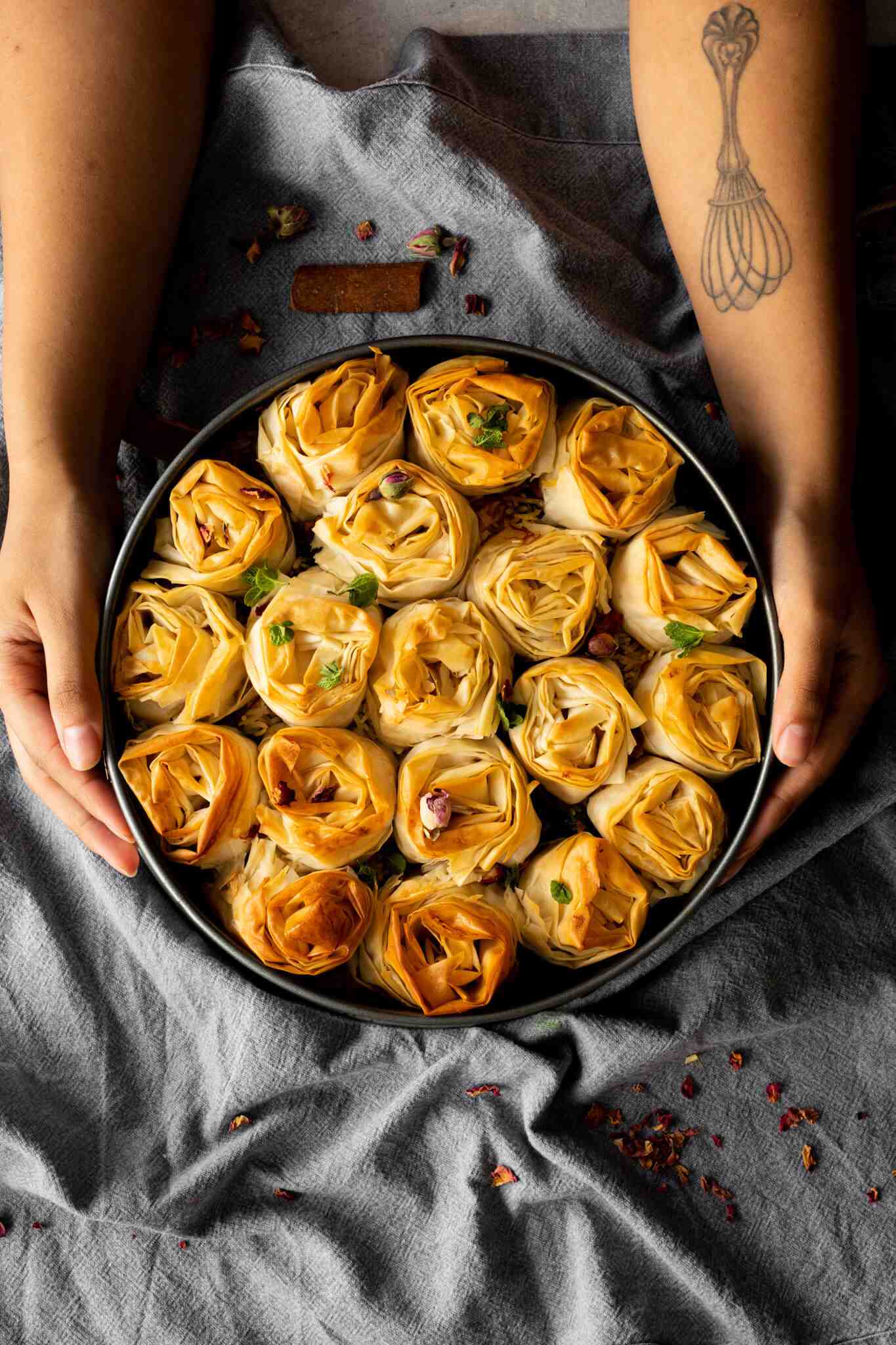This beautiful preparation of basmati rice and freshly-toasted spices takes serious thought, time and effort. From soaking the rice, to frying onions, and if you’re really committed, making your own glorious Biryani Masala, this is no 30-minute meal. Biryani is a food that you make for special occasions and sharing. It’s decadent, opulent and more of an emotion than it is a meal.
What is Ruffled Vegetable Biryani?
It’s a little twist on the original dough-sealed biryani with stunning golden filo pastry ruffles as the crowning glory. With each scoop of aromatic biryani, your friends and family can help themselves to a buttery pastry ruffle. These scrunched up bits of filo just melt in the mouth and they’re SO simple to make (even though it looks super fancy!). My favourite thing is that the butter from the pastry seeps down into the steamy rice to create rosy saffron steam that contrast with spices like cardamom and cloves. Indeed, this veg biryani will knock your socks clean off.
How to make Biryani Masala at home
Sure, a packet Biryani Masala mix has a place in the kitchen cupboard. It’s great for those days when you’re short of time, let’s not be snobby about it. However, there’s truly no match for a batch of homemade Biryani Masala. I toast whole spices until the oils release and become fragrant. It’s as satisfying to make as it is to eat. Plus, everything is fresh and you get to see exactly what goes in.
My all-in-one Homemade Biryani Masala
My Biryani Masala is an all-in-one recipe. I add dried chilli, garlic and ginger to the masala so you don’t need to add their fresh counterparts when you cook your biryani. I find this to be a welcome time saver since there are already so many other ingredients required.
How much Homemade Biryani Masala does this recipe make?
My recipe makes approximately 75g biryani masala, which is enough to make biryani for six people three times, give or take. Of course, this depends on the amount of masala you add to your dish. My calculations are based on adding 2 tablespoons of biryani masala to a biryani for 6 people (around 225g rice and 1.5kg of vegetables or protein).
Tips for making Homemade Biryani Masala
A dry frying pan is perfect for getting the spices nicely toasty. You don’t need to use oil for dry masalas.Don’t toast the spices over a high heat. A low heat will help coax the oils from the whole spices perfectly. Patience pays off.Keep the spices moving the whole time they’re in the pan to ensure they don’t burn. They have a tendency to catch in hotspots.Let the spices cool completely before you grind them.Store the homemade Biryani Masala in an airtight jar or container for up to six months. It’s okay to leave it beyond this date but the spices may lose some of their potency.I recommend making masalas in small batches so you can use them at their best.
What kind of Vegetable Biryani is this?
Absolutely not traditional is the answer. While it has all the flavours of a wonderful biryani, its presentation and method of preparation is unique. I never claim authenticity in recipes because I believe recipes are in a constant metamorphosis, informed by our environments and tastes. Purists will insist that there cannot be a vegetarian biryani as this dish has almost always been prepared with meat. My opinion is that if there can be plant-based “chicken” burgers, vegan “steak” and other no-meat meats, anything is possible. Every food has roots, or an origin of sorts. To deny the existence of something based on a belief that it shouldn’t be, doesn’t make it cease to exist. Enough chat. Let’s make biryani.
Why add pastry on top?
India’s most traditional biryanis are cooked in “Dum”. This refers to a seal of dough around the rim of a cooking pot so the food inside cooks in steam. A seal ensures steam builds up inside the pot, plumps up the rice grains and infuses them with the flavours of spiced veg, crispy onions (in the biryani layers) and saffron. Once you crack it open, the ‘Dum’, translated as “warm breath” will escape and you’ll be ready to pile mounds of biryani on your plate. This Ruffled Pastry Vegetable Biryani takes inspiration from the dum method but isn’t wholly traditional. I sprinkle the biryani is sprinkled with saffron milk which, along with the rice and veg releases steam upwards. The crispy filo pastry sits on top and since it’s spread with butter, the entire biryani soaks up the buttery drips that fall from above. It really is the veggie biryani of dreams.
Ruffled Pastry Vegetable Biryani: Troubleshooting
My biryani-making essentials (contains affiliate links)
A wet/dry grinder with a powerful motor is your best friend when it comes to grinding your own masalas. It’s an invaluable tool for this Biryani Masala. I have a Boss one which is years old but this Premier Xpress Mixer/Grinder is amazing.Indeed, if you’re looking for a one-stop quick fix that’s suitable for lots of things, try a coffee grinder like this Bosch Coffee Grinder. You’ll probably only want to use it for spices though. Nobody wants biryani-flavoured coffee… or do they?All the spices you need for this biryani can be found here.I use a springform cake tin like this for my Ruffled Vegetable Biryani but a casserole pot like this one or this one is ideal.Indeed, you can use your favourite brand of Basmati rice for this biryani. Some of my favourites include this Dehraduni Basmati Rice or the classic Daawat Extra-Long Grain Rice.
How to make Homemade Biryani Masala and Vegetable Biryani
Pin this Ruffled Pastry Vegetable Biryani for later!
If you like this, you’ll love my recipe for Saag Paneer
Share this recipe





























